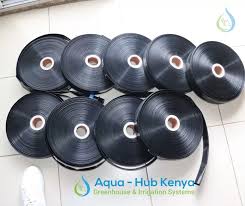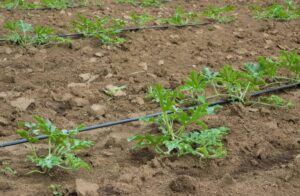This article guides you on the required things and How to Install Rain Hose Systems.
Aqua Hub Rain Hose Irrigation Systems are the best in the market retailing at a few dollars. We deliver quality rain hose pipes and systems to clients who want to revolutionize their agriculture.
Rain Hose Irrigation System
A rain hose irrigation method is an innovation that uses perforated pipes to supply water to crops. Rain hose pipes are special flexible tubes with many small holes on the surface that release water.
How Rain Hose Systems Work
Tiny sprays of water jet out in an upward throw that may reach a few meters from the pipe.
A rain hose irrigation system is a connection of rain hose pipes, start pipes, and fittings. All these components combine to form a functional system that distributes water to plants.
How to Ensure Rain Hose System is Operational
The goal of the rain hose system is to supply water to crops in fine thin jets at pressure. Therefore, the pipes should meet and withstand the pressure of the water to ensure the required flow rate is attained.
An ideal water pump should also be used to attain the pressure required for the rain hose pipes to release water.
Required Pressure and Specifications of Rain Hose Pipes
To run a rain hose irrigation system, the system needs a pressure rate of 0.8 – 1.5 bar. The irrigation method attains a flow radius of 2 – 6 m as per the pipe size.
To maintain a balance in water distribution from the pipe start to end, the length of laying should be as recommended. Laying lengths vary with the diameter of the pipes.
- 32 mm pipe laying length – 25-40 m.
- 40 mm pipe size – 30 – 50 m
- 50 mm pipe size – 70 – 80m
- 63 mm size – about 90 – 100m
What are the Requirements to Install Rain Hose Irrigation System
- Rain hose Pipes
- Adaptor
- Lay Flat Hose Pipe
- Ball Valves
- Straight Connector
- Lay Flat Take-off Fittings
- End Cap
How to Install Rain Hose Systems
- Set Up a pump near the Water Source in a suitable position.
- Connect the pump suction pipe to the water source, river, or dam.
- Set up and connect the lay flat Hose Pipe to the Water Supply Pump.
- Connect the mainline pipe to the rain hose pipes.
If the source of Water is from a tank;
- Ensure it is raised on a high point to generate the pressure needed in a rain hose system.
- Connect a tank connector and a male adaptor.
- Connect the Lay flat Hose Pipe to the male adaptor.
- Using a suitable connector link the lay flat hose pipe to the Rain hose pipe.
- Close the end lines of rain Hose tapes using End plugs
Purchasing Aqua Rain Hose Systems in Kenya
Follow the steps below to purchase Aqua Rain Hose Kits.
- Schedule a site visit to your Farm to check the suitability of a rain hose system.
- Ensure you have nearby access to a reliable water source. If not drill water or connect to a surplus water connection.
- Choose the ideal Rain hose kits and pipes that suit your crops.
- Contact us for orders concerning the kits you want. Order and pay.
Cost of Aqua Irrigation Rain Hose Systems
Our Rain hose kit prices depend on the type of rain hose tapes you want.
We have several types of Rain Hose pipes categorized according to the diameter of the pipe.
They include 32 mm, 40 mm, 50 mm, and 63 mm sizes.
- 32 mm – KES. 3,500.
- 40 mm – KES. 5,500.
- 50 mm – KES. 7,500.
Know more on how to install Rain Hose Systems. Aqua Hub’s spray rain hose pipes and fittings are readily available in the market.





